A right angle drill also known as a 90 degree drill is designed specifically for situations where there’s limited space to maneuver a regular power drill. This could be in between studs and joists, inside cabinets, or under sinks.
They’re designed to help you access tight or confined spaces, eliminating the need for you to work at any awkward angle, where it will be difficult for you to carry out your job.
Using a right angle drill also increases your accuracy in confined spaces because, since you’re not working in an awkward position, you have better control of the tool and thus are able to do a better job.
You’ll never know how important it is until you need it. There are several types of projects, tasks and situations where it comes in very handy, such as kitchen cabinet installations, plumbing work, HVAC installation and repair, home renovations, electrical wiring, automobile engine repair and so on.
These are all projects or examples of situations where you’ll surely need to drill holes, loose nuts or drive screws in tight or cramped spaces, and the only tool that will allow you to get that done comfortably is a right angle drill.
Table of Contents
What To Consider When Choosing A Right Angle Drill
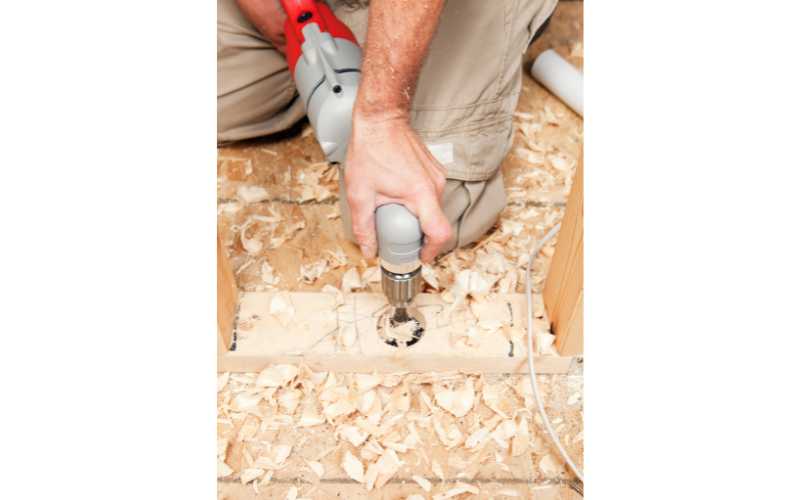
Here are important factors you must consider:
Consider The Tasks You Want To Use It For
The first thing you need to consider when choosing a right angle drill is the kind of job you intend to use it for. That’s because different units are designed with specific applications in mind. For furniture and cabinet making projects, a small right angle drill, like the Kobalt and the Makita DA3010F listed below should work just fine.
On the other hand, if you’re a plumber or electrician trying to drill holes between studs and joists for pipes to go through, you need a heavy duty stud and joist drill, like the Milwaukee Super Hawg or the Dewalt DCD460B also listed below. These are heavy-duty units that are designed for use with hole saws for drilling large holes in between studs and joists.
Clutch
A clutch is an important feature to consider when choosing a right angle drill because it allows you to control the torque output of the drill, which is especially important for applications where you need to avoid over-tightening or stripping screws.
The clutch is designed to disengage the motor from the chuck once a certain level of torque is reached, preventing the drill from driving the screw too deep or damaging the workpiece.
Without a clutch, it can be difficult to control the depth and tightness of screws, which can lead to errors or damage to the material you are working with. A clutch also reduces the risk of injury to the operator because too much torque can also make it difficult to control the drill, and might even cause injury to the operator.
Chuck Size
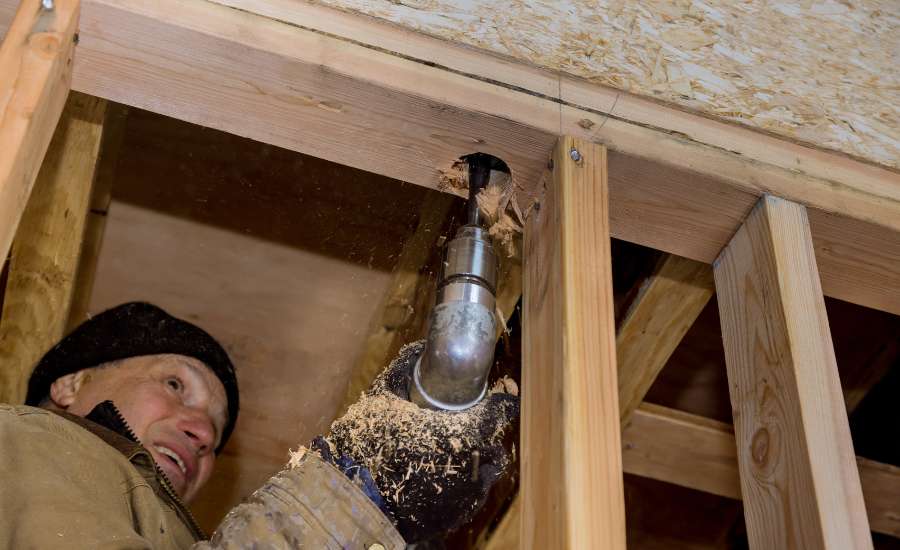
When choosing a drill of any kind, one of the first things I consider is the size of the chuck it has. This is very important because there are different sizes of bits. A small chuck cannot hold a large bit, hence if you work with large drill bits, it would make sense for you to go for a right angle drill with a larger chuck.
Larger chuck however, can mean that the tool will now be larger and heavier and may not be as compact as you want.
Most small right angle drills have a chuck size of 3/8 inch while large ones have a chuck size of 1/2 inch.
Tool Size
It’s important that you consider the size of a right angle drill because it can impact the drill’s versatility and accessibility in tight spaces.
A smaller, more compact right angle drill can fit into tighter areas and can be easier to handle for extended periods. On the other hand, a larger one may have more power but can be more challenging to maneuver in tight spaces, and may not even fit into smaller spaces like inside cabinets or under the hood of a car.
Variable Speed
It’s very important to consider speed because it determines the efficiency and precision of the tool itself. Different materials and drill bits require different speeds for it to work effectively. Thus, being able to adjust the speed allows you to control it better and ensures maximum performance.
Higher speeds are generally used for softer materials like wood, while lower speeds are better for harder materials like metal. If you can’t adjust the speed, then it will be difficult or even dangerous to use the same right angle drill for different materials.
With that out of the way, here are our top 6 selections of the best right angle drills.
1. Bosch PS11-102

Specifications:
Chuck Size: 3/8 inch, Max Torque: 115 in-lbs, Speed: 0-1300 RPM, Weight: 2.75 lbs, Type: Cordless, Battery Voltage: 12V, Clutch: No, Note: Battery and charger included.
Talking about right angle drills, Bosch offers something quite special with this model PS11-102.
The Bosch PS11-102 features a 5 position pivoting head that allows you to pivot the head from the 90 degrees position to 180 degrees.
This means, if you want, you can use it even in the tightest of spaces by just straightening the drilling head.
For power, it comes equipped with a 12V motor that produces up to 1300 rpm of speed and a maximum torque of 115 in-lbs, making it a very versatile tool you can use in different drilling and screw-driving applications.
A large variable speed trigger allows you to vary the speed of the motor easily just by varying the amount of force you exact on the trigger.
Equipped with a keyless chuck, changing bits is never a hassle.
The Bosch PS11-102 also comes equipped with a motor break, so that when you release the trigger, the break is applied, and you don’t screw or drive screws any further.
Overall, the design and the functionality of this Bosch PS11-102 makes it one of the best right angle drills I’ve ever seen.
What we like about it
Drawbacks
2. Kobalt 24V Max Right Angle Drill
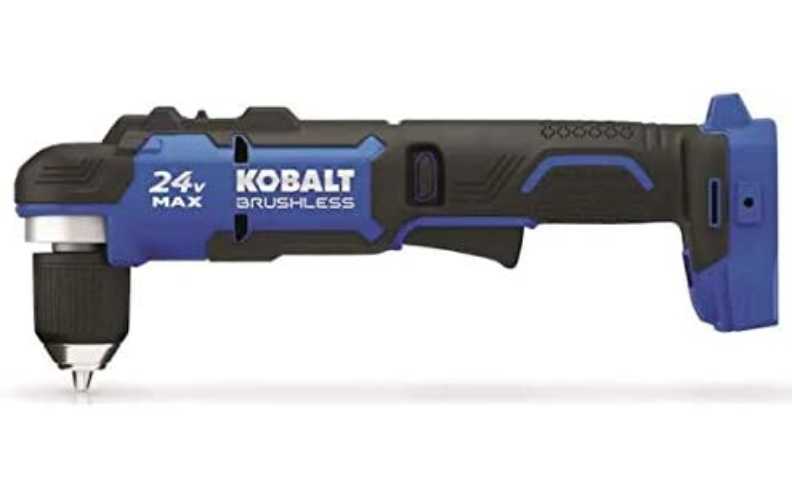
Specifications:
Chuck Size: 3/8 inch, Max Torque: 250 in-lbs, Speed: 2 variable speed (0-600 and 0-2000 RPM), Weight: 3.3 lbs, Type: Cordless, Battery Voltage: 24V, Clutch: 4-Mode Clutch Note: Battery and charger sold separately.
The Kobalt tool brand is not as popular as some of the other brands I’m used to, but it turns out they make some really impressive tools. For instance, this Kobalt 24 Volts Max 3/8 inch right angle drill is one of the most powerful compared to the other ones reviewed in this article. Although it’s not very common, it does stands up to and is even better than some of the competition.
It comes equipped with a brushless motor capable of producing up to 250 in-lbs of torque, with a maximum no-load speed of 2000 RPM.
Unlike similar models that have just a single speed setting, the Kobalt has 2 variable speed settings that allow you to adjust the speed to match your application. It has a low speed setting of 0-600 RPM and high speed setting of 0-2000 RPM.
The high speed setting is suitable for tasks that requires more speed than torque, like drive a screw or turning any other type of fastener.
On the other hand, the low speed setting is better for tasks that requires more torque like drilling through wood with a self-feeding bit.
The Kobalt right angle drill also features a 4-mode clutch that allows you really adjust the drill to fit each task you want to carry out.
An additional feature is an LED light that illuminates your work as soon as you press the trigger and stops after the chuck stops rotating.
With a 3.19 inch width from the chuck to the back of the drill head, the Kobalt is quite compact and can fit into tighter spaces than most of the competition.
What we like about it
Drawbacks
3. Milwaukee 1680-21 Super Hawg

Specifications:
Chuck Size: 1/2 inch, Speed: Dual speed (0-450 and 0-1750 RPM), Weight: 14.7 lbs, Type: Corded, Amperage: 13 amp, Clutch: Yes.
There’re only a few right angle drills that can go head-to-head with this Milwaukee 1680-21.
This is not just any right angle drill. This is the Milwaukee ½ inch Super Hawg. It’s a tool for the pros.
Professional electricians, plumbers and construction workers use this to drill hundreds of holes in studs and joist at different jobsites week-in week-out.
Equipped with a 13 Amp motor, the Milwaukee 1680-21 spins at a speed range of 450 rpm to 1750 rpm, allowing you to use it on a whole range of applications.
It features a soft-grip Roto-Lok handle which allows you to rotate the handle left to right at 90 degrees, allowing you to hold and operate it at the position you’re most comfortable with it.
There’s also a secondary T-bar handle you can screw close to the top of the head for more control during use.
It comes with a ½ inch chuck, total length of the Milwaukee 1680-21 is 22 inches and it weighs 14.7 lbs.
What we like about it
Drawbacks
4. Makita DA3010F Right Angle Drill

Specifications:
Chuck Size: 3/8 inch, Max Torque: 221 in-lbs, Speed: 0-2400 RPM, Weight: 3.5 lbs, Type: Corded, Amperage: 4 amp, Clutch: No.
The Makita DA3010F right angle drill comes equipped with a 4.0 Am motor producing a maximum speed of 2,400 rpm.
A ball bearing motor construction ensures a longer tool and motor life.
You can vary the speed from 0 to 2400 rpm making it very versatile for a range of applications.
The compact design (10-5/8 inch length) and lightweight structure (3.1 lbs.) allows you to use it even in very tight spaces.
Illuminating your work piece is a bright LED light built into it. The LED bulb never needs replacement so it will remain functional throughout the life of the tool.
Overall, the Makita DA3010F right angle drill is one of the best you can go for especially when you’re working between tight framing studs and inside cabinets.
What we like about it
Drawbacks
5. Ryobi P241
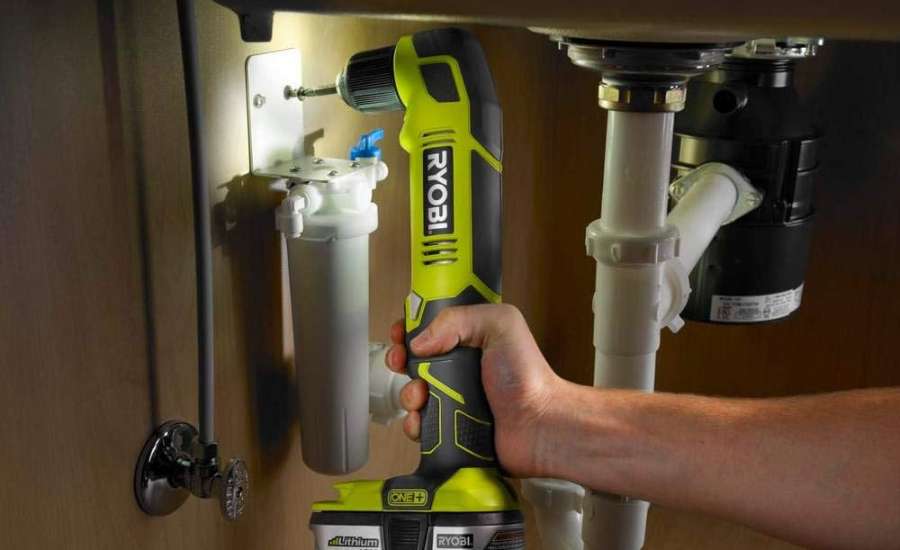
Specifications:
Chuck Size: 3/8 inch, Max Torque: 130 in-lbs, Speed: 1100 RPM, Weight: 2.7 lbs, Type: Cordless, Battery Voltage: 18V, Clutch: No.
When you’re really in that awkward position such that using a normal cordless power drill is literally impossible, one of your best options is to use this Ryobi P241.
The long neck design allows you a greater reach and leverage in awkward spaces such as when drilling between studs, installing HVAC systems or plumbing applications.
It comes equipped with a motor which spins the chuck at a rate of 1100 rpm and produces up to 130 inch pounds of torque.
Even when you’re working in really awkward positions like when you’re on your back, and holding your bits with your other hand is not just an option, the magnetic tray on the tool allows you to keep your bits on the tool, freeing up both of your hands to handle the work.
The handle is designed with hex rubber overmold, allowing you maximum grip on the tool even when you’re working in damp conditions (plumbing) that might cause the tool to slip in your hands.
If you’re talking about right angle or 90 degree drills, this Ryobi P241 is definitely one you can rely on.
What we like about it
Drawbacks
6. Dewalt DCD460B FLEXVOLT Stud And Joist Drill

Specifications:
Chuck Size: 1/2 inch, Max Torque: 1100 in-lbs, Speed: 0-300 / 0-1250 RPM, Weight: 24 lbs, Type: Cordless, Battery Voltage: 60V, Clutch: E-Clutch.
The Dewalt DCD460B 60V Flexvolt stud and joist drill is a very powerful and special type of right angle drill, ideal for drilling holes in studs and joists.
Basically, it’s ideal for timber framing and other building construction projects.
The 60V FLEXVOLT battery guarantees maximum power and runtime while working on your projects with it.
As for speed, the Dewalt DCD460B features 2 variable speed ranges you can choose from, 0 to 300 rpm and 0 to 1250 rpm. This allows you to vary the speed to match the project and to allow maximum control and precision.
Equipped with an E-clutch, the tool can detect reactionary torque in the case of a bind-up or stalling while in use, and it automatically reduces the speed for safety and ease of operation.
The Dewalt stud and joist right angle drill features 2 handles for operation. An adjustable bail handle and a 2 position side handle for maximum leverage and control during use.
If you have anyone in your life that’s a professional plumber or framer, try gifting them this tool and see their reaction.
What we like about it
Drawbacks

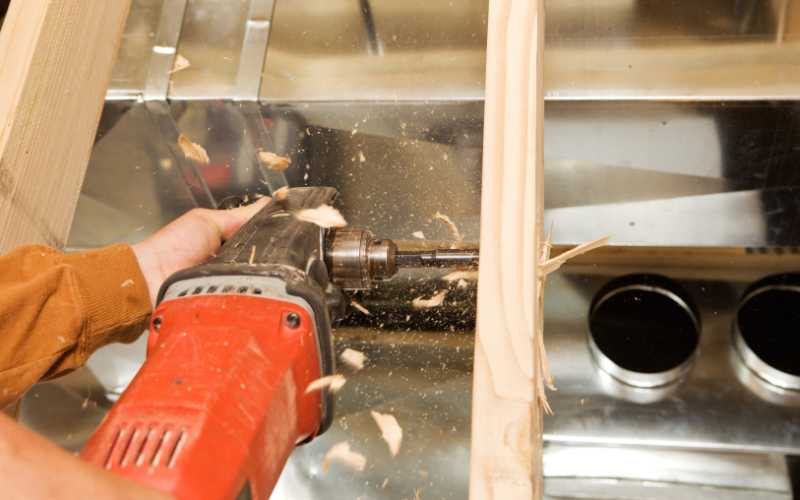
don’t forget the m18 hole hawg and super hawg